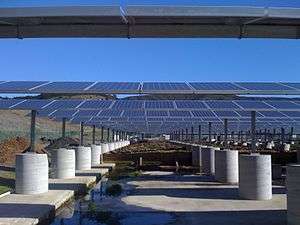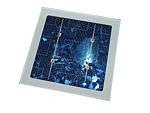Photovoltaic mounting system

Photovoltaic mounting systems (also called solar module racking) are used to fix solar panels on surfaces like roofs, building facades, or the ground.[1] These mounting systems generally enable retrofitting of solar panels on roofs or as part of the structure of the building (called BIPV).[2]
Roof mounting

The solar array of a PV system can be mounted on rooftops, generally with a few inches gap and parallel to the surface of the roof. If the rooftop is horizontal, the array is mounted with each panel aligned at an angle. If the panels are planned to be mounted before the construction of the roof, the roof can be designed accordingly by installing support brackets for the panels before the materials for the roof are installed. The installation of the solar panels can be undertaken by the crew responsible for installing the roof. If the roof is already constructed, it is relatively easy to retrofit panels directly on top of existing roofing structures. For a small minority of roofs (often not built to code) that are designed so that it is capable of bearing only the weight of the roof, installing solar panels demands that the roof structure must be strengthened before-hand. In all cases of retrofits particular consideration to weather sealing is necessary There are many low-weight designs for PV systems that can be used on either sloped or flat roofs (e.g. plastic wedges or the PV-pod), most however, rely on a type of extruded aluminum rails (e.g. Unirac). Recently, tension-based PV racking solutions have been tested successfully that reduce weight and cost.[3] In some cases, converting to composition shingles, the weight of the removed roof materials can compensate the additional weight of the panels structure. The general practice for installation of roof-mounted solar panels include having a support bracket per hundred watts of panels.[4][5]
Ground-mounted
Ground-mounted PV systems are usually large, utility-scale photovoltaic power stations. The PV array consist of solar modules held in place by racks or frames that are attached to ground based mounting supports.[6][7]
Ground-based mounting supports include:
- Pole mounts, which are driven directly into the ground or embedded in concrete.
- Foundation mounts, such as concrete slabs or poured footings
- Ballasted footing mounts, such as concrete or steel bases that use weight to secure the solar module system in position and do not require ground penetration. This type of mounting system is well suited for sites where excavation is not possible such as capped landfills and simplifies decommissioning or relocation of solar module systems.
Mounting as a shade structure

Solar panels can also be mounted as shade structures where the solar panels can provide shade instead of patio covers. The cost of such shading systems are generally different from standard patio covers, especially in cases where the entire shade required is provided by the panels. The support structure for the shading systems can be normal systems as the weight of a standard PV array is between 3 and 5 pounds/ft2. If the panels are mounted at an angle steeper than normal patio covers, the support structures may require additional strengthening. Other issues that are considered include:
- Simplified array access for maintenance.
- Module wiring may be concealed to maintain the aesthetics of the shading structure.
- Growing vines around the structure must be avoided as they may come in contact with the wiring.[4][5]
Building-integrated photovoltaics

Building-integrated photovoltaics (BIPV) are photovoltaic materials that are used to replace conventional building materials in parts of the building envelope such as the roof, skylights, or facades. They are increasingly being incorporated into the construction of new buildings as a principal or ancillary source of electrical power, although existing buildings may be retrofitted with BIPV modules as well. The advantage of integrated photovoltaics over more common non-integrated systems is that the initial cost can be offset by reducing the amount spent on building materials and labor that would normally be used to construct the part of the building that the BIPV modules replace.[8]
Orientation and inclination
A solar cell performs the best when its surface is perpendicular to the sun's rays, which change continuously over the course of the day and season. It is a common practice to tilt a fixed PV module (without solar tracker) at the same angle as the latitude of array's location to maximize the annual energy yield of module. For example, rooftop PV module at the tropics provides highest annual energy yield when inclination of panel surface is close to horizontal direction. A study in the tropics showed that the orientation of low-slope rooftop PV has negligible impact on annual energy yield, but in the case of PV external sunshade applications, east façade and panel slope of 30–40° are the most suitable location and inclination.[9]
References
- ↑ "Photovoltaic Racking Systems". solattach.com. Retrieved 2016-05-16.
- ↑ "What difference is there between thermal solar energy and Photovoltaic solar energy?". epia.org. Retrieved 2011-07-26.
- ↑ B.T. Wittbrodt & J.M. Pearce. Total U.S. cost evaluation of low-weight tension-based photovoltaic flat-roof-mounted racking.Solar Energy 117 (2015), 89–98.open access
- 1 2 "A GUIDE TO PHOTOVOLTAIC (PV) SYSTEM DESIGN AND INSTALLATION". ecodiy.org. Retrieved 2011-07-26.
- 1 2 "PROCEDURES FOR SOLAR ELECTRIC (PHOTOVOLTAIC abbreviated as PV) SYSTEM DESIGN AND INSTALLATIO" (PDF). thebii.org. Retrieved 2011-07-26.
- ↑ SolarProfessional.com Ground-Mount PV Racking Systems March 2013
- ↑ Massachusetts Department of Energy Resources Ground-Mounted Solar Photovoltaic Systems, December 2012
- ↑ "Building Integrated Photovoltaics (BIPV)". wbdg.org. Retrieved 2011-07-26.
- ↑ Saber, Esmail M.; Lee, Siew Eang; Manthapuri, Sumanth; Yi, Wang; Deb, Chirag (July 2014). "PV (photovoltaics) performance evaluation and simulation-based energy yield prediction for tropical buildings". Energy. 71: 588–595. doi:10.1016/j.energy.2014.04.115.
See also
- Solar tracker
- MPPT
- Rooftop photovoltaic power station
- Stand-alone photovoltaic power system
- Grid-connected photovoltaic power system
